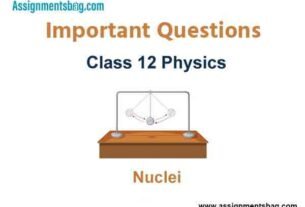Please refer to Solutions Class 12 Chemistry Important Questions with solutions provided below. These questions and answers have been provided for Class 12 Chemistry based on the latest syllabus and examination guidelines issued by CBSE, NCERT, and KVS. Students should learn these problem solutions as it will help them to gain more marks in examinations. We have provided Important Questions for Class 12 Chemistry for all chapters in your book. These Board exam questions have been designed by expert teachers of Standard 12.
Class 12 Chemistry Important Questions Solutions
Very Short Answer Questions
Question. Defne the following term :
Molarity
Answer. Number of moles of solute dissolved in one litre solution is called molarity. It is denoted by M.

Question. Defne the following term :
Mole fraction
Answer. Mole fraction is the ratio of number of moles of solute or solvent and total number of moles of solution. It is denoted by x.

Question. What are isotonic solutions?
Answer. Two solutions having same osmotic pressure at a given temperature are called isotonic solutions
Question. Defne the following term :
Molal elevation constant (Kb)
Answer. Molal elevation constant may be defined as the elevation in boiling point when the molality of the solution is unity (i.e., 1 mole of the solute is dissolved in 1 kg (1000 g) of the solvent). The units of Kb are therefore, degree/molality i.e., K/m or °C/m or K kg mol–1.
Question. How is the vapour pressure of a solvent affected when a non-volatile solute is dissolved in it?
Answer. When a non-volatile solute is added to a solvent, the vapour pressure of the solvent (above the resulting solution) is lower than the vapour pressure above the pure solvent.
Question. Define the following term :
Osmotic pressure
Answer. Osmotic pressure is the extra pressure which is applied on the solution to just prevent the flow of solvent into the solution through a semi-permeable membrane.
Question. Defne Raoult’s law.
Answer. Raoult’s law : For a solution of volatile liquids, the partial pressure of each component in the
solution is directly proportional to its mole fraction.
Thus, for any component, partial vapour pressure, p ∝ x ⇒ p = p°. x
where p° = vapour pressure of pure component x = mole fraction of that component
Question. In non-ideal solution, what type of deviation shows the formation of maximum boiling azeotropes?
Answer. Non-ideal solutions that show negative deviation from Raoult’s law form maximum boiling azeotropes.
Question. Explain the following :
Boiling point elevation constant for a solvent.
Answer. Ebullioscopic constant is the boiling point elevation constant when one mole of solute is dissolved in 1000 g of solvent. It is denoted by Kb
Question. What is meant by colligative properties?
Answer. Colligative properties are the properties of solution which depend upon the number of solute particles and not upon the nature of the solute.
Short Answer Questions
Question. Calculate the molarity of 9.8% (w/W) solution of H2SO4 if the density of the solution is 1.02 g mL–1.
(Molar mass of H2SO4 = 98 g mol–1)
Answer. Mass of solute = 9.8 g
Mass of solution = 100 g
Density of solution = 1.02 g mL–1

Question. Assuming complete dissociation, calculate the expected freezing point of a solution prepared by dissolving 6.00 g of Glauber’s salt, Na2SO4⋅10H2O in 0.100 kg of water.
(Kf for water = 1.86 K kg mol–1, atomic masses :
Na = 23, S = 32, O = 16, H = 1)
Answer. Molecular mass of Na2SO4⋅10H2O
= [2 × 23 + 32 + 16 × 4 + 10 × (2 × 1 + 16)]
= (46 + 32 + 64 + 180) g mol–1 = 322 g mol–1
Na2SO4⋅10H2O ionises as :

Question. Differentiate between molarity and molality of a solution. How can we change molality value of a solution into molarity value?
Answer.


Question. What is meant by negative deviation from Raoult’s law? Give an exmaple. What is the sign of ΔmixH for negative deviation?
Answer. Negative deviation : For non-ideal solution, if the vapour pressure is lower, then it is said to exhibit negative deviation. A — B interactions are stronger than A — A and B — B interactions. Due to this, vapour pressure decreases which results in negative deviation. In negative deviation, intermolecular force increases, volume decreases, vapour pressure decreases and heat is released. Therefore, ΔHmix = –ve, ΔVmix = – ve Example, phenol + aniline and chloroform + acetone show negative deviation.

Question. An aqueous solution of sodium chloride freezes below 273 K. Explain the lowering in freezing point of water with the help of a suitable diagram.
Answer. When a non-volatile solute is added to a solvent, the freezing point of the solution is always lower than that of pure solvent as the vapour pressure of the solvent decreases in the presence of non-volatile solute. Plot for the lowering in freezing point of water when NaCl is added to it is shown as :

Question. Define the terms osmosis and osmotic pressure.
Is the osmotic pressure of a solution a colligative property? Explain.
Answer. Osmosis : The spontaneous movement of the solvent molecules from the pure solvent or from a dilute solution to a concentrated solution through a semi-permeable membrane is called osmosis.
Osmotic Pressure : The minimum excess pressure that has to be applied on the solution to prevent the passage of solvent molecules into it through semipermeable membrane is called osmotic pressure.
Osmotic pressure is a colligative property because it depends on the number of solute particles and not
on their nature.
Question. A 1.00 molal aqueous solution of trichloroacetic acid (CCl3COOH) is heated to its boiling point. The solution has the boiling point of 100.18°C. Determine the van’t Hoff factor for trichloroacetic acid.
(Kb for water = 0.512 K kg mol–1)
Answer. Molality of solution, m = 1.00 m
Boiling point of solution, Tb = 100.18°C = 373.18 K
Boiling point of water (solvent), T°b = 100.00°C = 373 K
ΔTb = Tb – T°b = 373·18 K – 373 K = 0·18 K
ΔTb = i Kb⋅m
0.18 K = i × Kb⋅m
0.18 K = i × 0.512 K kg mol–1 × 1 mol kg–1

Question. Explain why aquatic species are more comfortable in cold water rather than in warm water.
Answer. Increase in temperature decreases the solubility of oxygen in water. As a result, amount of dissolved oxygen decreases. It becomes more difficult to breathe as oxygen is less. Hence, the aquatic species are not comfortable in warm water.
Question. What is meant by positive deviations from Raoult’s law? Give an example. What is the sign of ΔmixH for positive deviation?
Answer. Positive deviation : For non-ideal solutions, if the vapour pressure is higher, then it is said to exhibit positive deviation. A B interactions are weaker than A A or B B interactions. Due to this, vapour pressure increases which results in positive deviation. In positive deviation, intermolecular force decreases, volume increases, vapour pressures increases. enthalpy increases. Therefore, ΔHmix = +ve, DVmix = + ve. e.g., ethanol + acetone and carbon disulphide + acetone show positive deviation.

Question. What type of intermolecular attraction exists in each of the following pairs of compounds :
(i) n-hexane and n-octane
(ii) methanol and acetone
Answer. (i) n-Hexane and n-octane : London dispersion forces as both the molecules are non-polar.
(ii) Methanol and acetone : Dipole-dipole interactions as both the molecules are polar.
Question. List any four factors on which the colligative properties of a solution depend.
Answer. (i) Number of particles of solute
(ii) Association or dissociation of solute
(iii) Concentration of solute
(iv) Temperature
Question. What type of deviation is shown by a mixture of ethanol and acetone? Give reason.
Answer. A mixture of ethanol and acetone shows positive deviation from Raoult’s law. Pure ethanol possesses hydrogen bonding. Introduction of acetone between the molecules of ethanol results in breaking of some of these hydrogen bonds. Due to weakening of interactions, the solution shows positive deviation from Raoult’s law.
Question. Explain why a solution of chloroform and acetone shows negative deviation from Raoult’s law.
Answer. A mixture of chloroform and acetone shows negative deviation from Raoult’s law because chloroform molecule forms H-bonding with acetone molecule. As a result of this A — B interaction becomes stronger than A — A and B — B interactions This leads to the decrease in vapour pressure and
resulting in negative deviation.

Question. A solution of glucose (C6H12O6) in water is labelled as 10% by weight. What would be the molality of the solution?
(Molar mass of glucose = 180 g mol–1)
Answer. Mass of solution = 100 g
Mass of solute = 10 g

Long Answer Questions
Question. 3.9 g of benzoic acid dissolved in 49 g of benzene shows a depression in freezing point of 1.62 K. Calculate the van’t Hoff factor and predict the nature of solute (associated or dissociated).
(Given : Molar mass of benzoic acid = 122 g mol–1, Kf for benzene = 4.9 K kg mol–1)
Answer. W2 = 3.9 g, W1 = 49 g, ΔTf = 1.62 K, M2 = 122 g mol–1,
Kf = 4.9 K kg mol–1

Question. What concentration of nitrogen should be present in a glass of water at room temperature? Assume a temperature of 25°C, a total pressure of 1 atmosphere and mole fraction of nitrogen in air of 0.78.
[KH for nitrogen = 8.42 × 10–7 M/mm Hg]
Answer. T = 25°C + 273 = 298 K
Total pressure (Ptotal) = 1 atm
PN2 = mol fraction of N2 in air × Ptotal = 0.78 × 1 atm
= 0.78 atm = 0.78 × 760 mm = 592.8 mm
As KH is in the units of M(mm)–1, Henry’s law is applied in the form :
Conc. in solution = KH PN2 = 8.42 × 10–7 M (mm)–1× 592.8 mm
= 4.99 × 10–4 M
Question. A solution of glucose (molar mass = 180 g mol–1) in water is labelled as 10% (by mass). What would be the molality and molarity of the solution?
(Density of solution = 1.2 g mL–1)
Answer. Given : Mass of solute, W2 = 10 g
Mass of solvent, W1 = 90 g
Molar mass of solute, M2 = 180 g mol–1
Density of solution = 1.2 g mL–1

Question. (i) The depression in freezing point of water observed for the same molar concentration of acetic acid, trichloroacetic acid and trifluroacetic acid increases in the order as stated above. Explain.
(ii) Calculate the depression in freezing point of water when 20.0 g of CH3CH2CHClCOOH is added to 500 g of water.
Answer. (i) The depression in freezing point is in the order :
Acetic acid < trichloroacetic < trifluoroacetic acid

Fluorine has the highest electron withdrawing inductive effect (–I effect) so trifluoroacetic acid is the strongest acid and acetic acid is the weakest acid. Therefore, trifluoroacetic acid ionises to the greater extent and acetic acid ionises to the minimum extent. Greater the number of ions produced, greater is the depression in freezing point.
(ii) Molar mass of CH3CH2CHClCOOH
= 4 × 12 + 7 × 1 + 35.5 + 2 × 16 = 122.5 g mol–1


Question. A solution prepared by dissolving 8.95 mg of a gene fragment in 35.0 mL of water has an osmotic pressure of 0.335 torr at 25°C. Assuming the gene fragment is a non-electrolyte, determine its molar mass.
Answer.
WB = 8.95 mg = 8.95 × 10–3 g,
R = 0.0821 L atm K–1 mol–1, V = 35 × 10–3 L

Question. 100 mg of a protein is dissolved in just enough water to make 10.0 mL of solution. If this solution has an osmotic pressure of 13.3 mm Hg at 25°C, what is the molar mass of the protein?
(R = 0.0821 L atm mol–1 K–1 and 760 mm Hg = 1 atm.)
Answer. W2 = 100 mg = 0.1 g,
V = 10.0 mL = 0.01 L,

Question. Calculate the amount of sodium chloride which must be added to one kilogram of water so that the freezing point of water is depressed by 3 K.
[Given : Kf = 1.86 K kg mol–1, atomic mass : Na = 23.0, Cl = 35.5]
Answer. W1 = 1 kg = 1000 g, ΔTf = 3 K
Kf = 1.86 K kg mol–1
M2(NaCl) = 23 + 35.5 = 58.5 g mol–1

Question. x g of a non-electrolytic compound (molar mass = 200) is dissolved in 1.0 L of 0.05 M NaCl aqueous solution. The osmotic pressure of this solution is found to be 4.92 atm at 27°C. Calculate the value of x. Assume complete dissociation of NaCl and ideal behaviour of the solution. (R = 0.082 L atm mol–1 K–1)
Answer. Total moles in solution


Question. What would be the molar mass of a compound if 6.21 g of it dissolved in 24.0 g of chloroform to form a solution that has a boiling point of 68.04°C. The boiling point of pure chloroform is 61.7°C and the boiling point elevation constant, Kb for chloroform is 3.63°C/m.
Answer. W2 = 6.21 g, W1 = 24.0 g
Tb = 68.04 °C, T°b
= 61.7 °C and Kb = 3.63 °C/m
ΔTb = Tb – T°b = 68.04 °C – 61.7 °C = 6.34 °C

Question. A solution containing 15 g urea (molar mass = 60 g mol–1) per litre of solution in water has the same osmotic pressure (isotonic) as a solution of glucose (molar mass = 180 g mol–1) in water.
Calculate the mass of glucose present in one litre of its solution.
Answer. Mass of urea = 15 g
Molar mass of urea = 60 g mol–1
Molar mass of glucose = 180 g mol–1
Mass of glucose = ?
For isotonic solution, osmotic pressure, π1 = π2
n1 = n2 (when volume is same)

Question. Calculate the boiling point elevation for a solution prepared by adding 10 g of CaCl2 to 200 g of water. (Kb for water = 0.52 K kg mol–1, molar mass of CaCl2 = 111 g mol–1)
Answer. Mass of CaCl2 (W2) = 10 g
Mass of water (W1) = 200 g
Molar mass of CaCl2 (M2) = 111 g mol–1
Molal Elevation constant = 0.512 K kg mol–1

ΔTb = Kb m = 0.512 × 0.450 = 0.2306 K
Question. Some ethylene glycol, HOCH2CH2OH, is added to your car’s cooling system along with 5 kg of water. If the freezing point of water-glycol solution is –15.0°C, what is the boiling point of the solution?
(Kb = 0.52 K kg mol–1 and Kf = 1.86 K kg mol–1 for water)
Answer. Tf = –15°C, Kf = 1.86 K kg mol–1
ΔTf = Tf Tf° − = 0 – (–15°C) = 15°C = 288 K
ΔTf = Kf × m

Question. What mass of NaCl must be dissolved in 65.0 g of water to lower the freezing point of water by 7.50°C? The freezing point depression constant (Kf) for water is 1.86°C/m. Assume van’t Hoff factor for NaCl is 1.87.
(Molar mass of NaCl = 58.5 g mol–1).
Answer. W1 = 65.0 g, ΔTf = 7.50°C,
Kf = 1.86°C/m, i = 1.87 and M2 = 58.5 g mol–1

Question. Calculate the mass of NaCl (molar = 58.5 g mol–1) to be dissolved in 37.2 g of water to lower the freezing point by 2°C, assuming that NaCl undergoes complete dissociation.
(Kf for water = 1.86 K kg mol–1)
Answer.

Question. An aqueous solution containing 12.48 g of barium chloride in 1.0 kg of water boils at 373.0832 K. Calculate the degree of dissociation of barium chloride.
[Given Kb for H2O = 0.52 K m–1;
Molar mass of BaCl2 = 208.34 g mol–1]
Answer. Here, n = 3 because 1 molecule of BaCl2 on dissociation gives three ions.
W2 = 12.48 g, W1 = 1.0 kg = 1000 g
Tb = 373.0832 K, Kb for H2O = 0.52 K m–1 and M2(BaCl2) = 208.34 g mol–1
ΔTb = Tb – T°b = 373.0832 K – 373 K = 0.0832 K

Question. A decimolar solution of potassium ferrocyanide K4[Fe(CN)6] is 50% dissociated at 300 K.
Calculate the value of van’t Hoff factor for potassium ferrocyanide.
Answer.

Question. Determine the osmotic pressure of a solution prepared by dissolving 2.5 × 10–2 g of K2SO4 in 2 L of water at 25°C, assuming that it is completely dissociated.
(R = 0.0821 L atm K–1 mol–1, molar mass of K2SO4 = 174 g mol–1)
Answer.
Mass of K2SO4, W2 = 2.5 × 10–2 g
Molar mass of K2SO4, M2 = 174 g mol–1
V = 2 L, T = 25°C = 298 K
R = 0.0821 L atm K–1 mol–1

Long Answer Type Questions-II
Question. (i) The vapour pressure of benzene and toluene at 293 K are 75 mm Hg and 22 mm Hg respectively.23.4 g of benzene and 64.4 g of toluene are mixed. If the two form an ideal solution, calculate the mole fraction of benzene in the vapour phase assuming that the vapour pressures are in equilibrium with the liquid mixture at this temperature.
(ii) What is meant by + ve and – ve deviations from Raoult’s law and how is the sign of ΔH solution related to + ve and – ve deviations from Raoult’s law ?
Answer. (i) Calculation of the total vapour pressure
Moles of benzene (nA)

Mole fraction of toluene (χB)
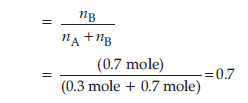
Vapour pressure of toluene in solution (pA)
= p°A × χA = (75 mm) × 0.3
= 22.5 mm
Vapour pressure of toluene in solution (pB)
= p°B × χB
= (22 mm) × 0.7
= 15.4 mm
Total vapour pressure of solution
= pA + pB
= 22.5 + 15.4
= 37.9 mm
Calculation of mole fraction of benzene in the vapour phase:
Mole fraction of benzene in vapour phase
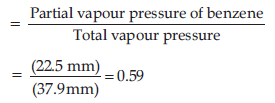
(ii) Solutions showing positive deviations, the partial vapour pressure of each component of solution is greater than the vapour pressure as expected according to Raoult’s law.
Solutions showing negative deviations, the partial vapour pressure of each component of solution is less than vapour pressure as expected according to Raoult’s law.
For positive deviation ΔmixH = + ve
For negative deviation ΔmixH = – ve
Question. (i) Explain the following :
(a) Henry’s law about dissolution of a gas in a liquid,
(b) Boiling point elevation constant for a solvent.
(ii) A solution of glycerol (C3H8O3) in water was prepared by dissolving some glycerol in 500 g of water. This solution has a boiling point of 100.42°C.
What mass of glycerol was dissolved to make this solution ? [Kb for water = 0.512 K kg mol–1]
Answer. (i) (a) The partial pressure of the gas above the liquid (vapour phase) is directly proportional to the mole fraction of the gas dissolved in the liquid.
(b) Boiling Point Elevation Constant : It is equal to elevation in boiling point of 1 molal solution, i.e.,
mole of solute is dissolved in 1 kg of solvent. (or mathematical expression)
(ii) WB = ? WA = 500 g ΔTb = 100.42°C – 100°C = 0.42°C
or 0.42K
Kb = 0.512 Kkg/mol MB = 92g/mol

Question. Why is the mass determined by measuring a colligative property in case of some solutes abnormal? Discuss it with the help of Van’t Hoff factor.
Answer. Certain compounds when dissolved in suitable solvents either dissociate or associate.
For example, ethanoic acid dimerizes in benzene due to hydrogen bonding, while in water, it dissociates and forms ions. As a result, the number of chemical species in solution increases or decreases as compared to the number of chemical species of solute added to form the solution. Since, the magnitude of colligative property depends on the number of solute particles, it is expected that the molar mass determined on the basis of colligative properties will be either higher or lower than the expected value or the normal value and is called abnormal molar mass.
In order to account for the extent of dissociation or association of molecules in solution, Van’t Hoff introduced a factor, i, known as the Van’t Hoff factor.
Question. (i) A 10% solution (by mass) of sucrose in water has a freezing point of 269.15 K. Calculate the freezing point of 10% glucose in water if the freezing point of pure water is 273.15 K. Given:
(Molar mass of sucrose = 342 g mol-1)
(Molar mass of glucose = 180 g mol-1)
(ii) Define the following terms:
(a) Molality (m)
(b) Abnormal molar mass
Answer.

(ii) (a) Number of moles of solute dissolved in per kilo gram of the solvent.
(b) Abnormal molar mass: If the molar mass calculated by using any of the colligative properties to be different than theoretically expected molar mass.
Question. How can you remove the hard calcium carbonate layer of the egg without damaging its semipermeable membrane? Can this egg be inserted into a bottle with a narrow neck without distorting its shape? Explain the process involved.
Answer. This can be achieved as under :
(i) Place the egg in a mineral acid solution for about 2 hours. The outershell of the egg dissolves. Remove any portion left with your fingers.
(ii) Place the egg in a saturated solution (hypertonic) of sodium chloride for about 3 hours. Size of the egg is reduced as the egg shrivels due to osmosis.
(iii) Insert the egg in a bottle with a narrow neck. Add water to the bottle. Water will act as hypotonic solution. Egg regains shape due to osmosis. This is shown diagrammatically as under :
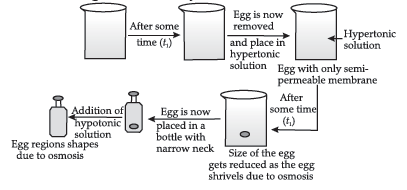
Question. (i) Define the following terms:
(a) Ideal solution
(b) Osmotic pressure.
(ii) Calculate the boiling point elevation for a solution prepared by adding 10 g CaCl2 to 200 g of water, assuming that CaCl2 is completely dissociated. (Kb for water = 0.512 K kgmol-1; Molar mass of CaCl2 = 111 g mol-1)
Answer. (i) (a) The solution which obey Raoult’s law over the entire range of concentration.
(b) It is the excess pressure that must be applied to a solution to prevent osmosis.
(ii) ΔTb = iKbm

Question. (i) Define the following terms :
(a) Molarity
(b) Molal elevation constant (Kb)
(ii) A solution containing 15 g urea (molar mass = 60 g mol–1) per litre of solution in water has the same osmotic pressure (isotonic) as a solution of glucose
(molar mass = 180 g mol–1) in water. Calculate the mass of glucose present in one litre of its solution.
Answer. (i) (a) Molarity : Molarity of a substance in a solution is equal to the number of moles of the substance present in one litre of the solution.
i.e. Molarity = No. of moles of substance/Volume of solution in L
(b) Molal elevation constant : It is also called ebullioscopic constant. It is equal to the change in boiling point of one molar solution.
ΔTb = Kb.m
(ii) Given; Mass of urea, WB = 15 g
Molar mass of urea, MB = 60 g
The solution of urea in water is isotonic to that of glucose solution.
So,πurea = πGlucose

WGlucose = 45 g
So, 45 g of glucose is present in 1 L of solution.
Question. (i) A 5% solution (by mass) of cane – sugar in water has freezing point of 271 K. Calculate the freezing point of 5% solution (by mass) of glucose in water if the freezing point of pure water is 273.15 K.
[Molecular masses : Glucose C6H12O6 : 180 amu;
Cane – sugar C12H12O11 : 342 amu]
(ii) State Henry’s law and mention two of its important applications.
Answer. (i) 5% by mass cane sugar = 5 g cane sugar
(Mol. wt = 342 amu in 100 g solution)

5% by mass glucose = 5 g glucose (Mol. wt = 180 amu)in 100 g solution

= 4.085 K
Tf = 273.15 – 4.085
Freezing point of glucose solution,
Tf = 269.065 K
(ii) According to Henry’s law, the partial pressure of a gas in vapour phase (p) is directly proportional to the mole fraction (x) of the gas in the solution.
Henry’s law is applied in the production of carbonated beverages and for the deep-sea-divers.
Question. (i) Define the following terms :
(a) Ideal solution
(b) Azeotrope
(c) Osmotic pressure
(ii) A solution of glucose (C6H12O6) in water is labelled as 10% by weight. What would be the molality of the solution ?
(Molar mass of glucose = 180 g mol–1)
Answer. (i) (a) Ideal solution : Those solutions which follow Raoult’s law at specific temperature over the entire range of concentration are called ideal solution.
(b) Azeotrope : A liquid mixture which distills at constant temperature without under going any changes in composition is called azeotrope.
(c) Osmotic pressure : The minimum excess pressure that has to be applied on the solution side to prevent the entry of the solvent into the solution through the semipermeable membrane is called osmotic pressure.
(ii) Given : Mass of solute, w = 10 g
Mass of solvent, W = 90 g
Molar mass of solute, M = 180

Question. (i) Define the following terms :
(a) Mole fraction,
(b) Ideal solution.
(ii) 15.0 g of an unknown molecular material is dissolved in 450 g of water. The resulting solution freezes at – 0.34 °C. What is the molar mass of the material ? [Kf for water = 1.86 K kg mol–1]
Answer. (i) (a) The ratio of number of moles of one component to the total number of moles of solution is known as mole fraction.
(b) The solution which follows Raoult’s law over entire range of concentration at specific temperature is called ideal solution.
(ii) WB = 15 g, WA = 450 g, DTf = 0.34 K, MB = ?

Question. (i) Explain why on addition of 1 mol glucose to 1 litre water the boiling point of water increases.
(ii) Henry’s law constant for CO2 in water is 1.67 ´ 108 Pa at 298 K. Calculate the number of moles of CO2 in 500 ml of soda water when packed under 2.53 ´ 105 Pa at the same temperature.
Answer.

Question. (i) What type of deviation is shown by a mixture
of ethanol and acetone ? Give reason.
(ii) A solution of glucose (molar mass = 180 g mol–1) in water is labelled as 10% (by mass). What would be the molality and molarity of the solution ?
(Density of solution = 1.2 g mL–1)
Answer. (i) It shows positive deviation.
It is due to weaker interaction between acetone and ethanol than ethanol-ethanol interactions.
(ii) Given : WB = 10 g, WS = 100 g, WA = 90 g,
MB = 180 g/mol and d = 1.2 g/mL
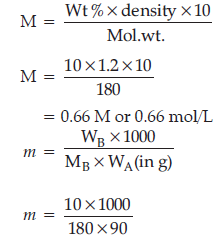
= 0.61 m or 0.61 mol/kg
Question. (i) Calculate the freezing point of solution when 1.9 g of MgCl2 (M = 95 g mol–1) was dissolved in 50g of water, assuming MgCl2 undergoes complete ionization. (Kf for water = 1.86 K kg mol–1)
(ii) (a) Out of 1 M glucose and 2 M glucose, which one has a higher boiling point and why?
(b) What happens when the external pressure applied becomes more than the osmotic pressure of solution ?
OR
(i) When 2.56 g of sulphur was dissolved in 100 g of CS2, the freezing point lowered by 0.383 K. Calculate the formula of sulphur (SX). (Kf for CS2 = 3.83 K kg mol–1,Atomic mass of Sulphur = 32 g mol–1).
(ii) Blood cells are isotonic with 0.9% sodium chloride solution. What happens if we place blood cells in a solution containing;
(a) 1.2% sodium chloride solution ?
(b) 0.4% sodium chloride solution ?
Answer.

= 2.23 K
ΔTf – ∆Tf’ = 273.15 – 2.23
Tf’ = 270.92 K
(ii) (a) 2 M glucose has a higher boiling point because higher the number of particles lesser is the vapour pressure.
(b) Reverse osmosis.
OR

M = 256
S × x = 256
32 × x = 256
x = 8
(ii) (a) If we place blood cells in solution containing 1.2% sodium chloride solution, they shrink.
(b) It we place blood cells in solution containing 0.4% sodium chloride solution, they swell.
Question. (i) State Raoult’s law for a solution containing volatile components. How does Raoult’s law becomes a special case of Henry’s law ?
(ii) 1.00 g of a non-electrolyte solute dissolved in 50 g of benzene lowered the freezing point of benzene
by 0.40 K. Find the molar mass of the solute. (Kf for benzene = 5.12 K kg mol–1).
Answer. (i) Partial vapour pressure of a liquid component is directly proportional to its mole fraction in its solution.
The partial pressure of the volatile component or gas is directly proportional to its mole fraction in solution. Only the proportionality constant KH differs from pA°. Thus, Raoult’s law becomes a special case of Henry’s law in which KH becomes
equal to pA°.
(ii) Given, WB = 1.00 g, WA = 50 g, Kf = 5.12 K kg mol–1;
ΔTf = 0.40 K



